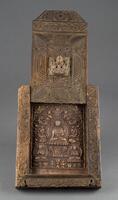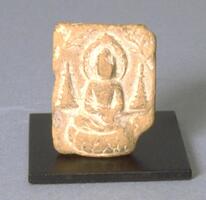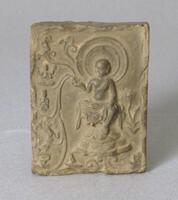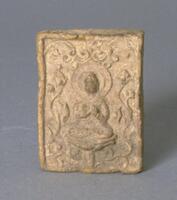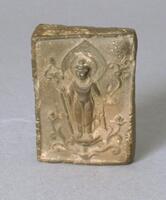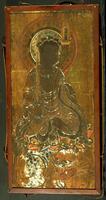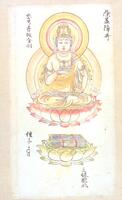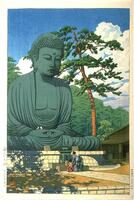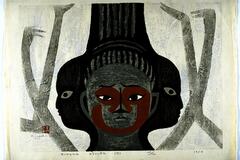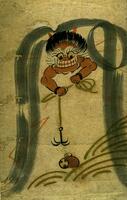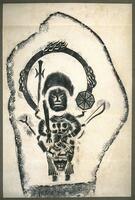22 Items in this Learning Collection
Collection Object
Collection Object
Collection Object
Collection Object
Collection Object
Collection Object
Collection Object
Collection Object
Collection Object
Collection Object
Collection Object
Collection Object
Collection Object
Collection Object
Collection Object
Collection Object
Collection Object
Collection Object
Copyright
All Rights Reserved
()
Ôtsu-e: The Thunder God Fishing for His Drum
Accession Number
1987/1.368
Title
Ôtsu-e: The Thunder God Fishing for His Drum
Artist(s)
Japanese
Artist Nationality
Japanese (culture or style)
Object Creation Date
20th century
Medium & Support
hanging scroll, ink and color on paper
Dimensions
17 3/8 in. x 10 7/16 in. ( 44.2 cm x 26.5 cm )
Credit Line
Gift of Dr. and Mrs. J.E. Val-Mejias, M.D.
Label copy
These paintings are examples of Otsu-e, a type of folk painting originating not far from Kyoto in the present-day Shiga Prefecture towns of Otsu, Oiwake, and Otani. Due to Otsu’s prime location on the Eastern Sea Road linking Kyoto with Tokyo, paintings from Oiwake and Otani eventually became subsumed under the title of Otsu-e. Initially religious in content, Otsu-e proliferated in the late sixteenth and early seventeenth century when Christianity was officially banned; they could be purchased easily and hung in the home as proof of Buddhist piety. Otsu-e were produced with cheap local materials and stencils were used to facilitate mass production, making them affordable even to the lower classes.
By the latter half of the seventeenth century, Otsu-e became more secular. The Thunder God (Raijin), for example, a powerful and ferocious figure, could be seen comically fishing for his drum, carelessly dropped in the ocean. Mischievous demons, like the one on display, were depicted in priest’s garb begging for alms. Here the painting is accompanied by text, which became common on images with moralistic messages poking fun at society. These humorous paintings had strong popular appeal, and made their way into the art and literature of famous Edo period figures. Otsu-e with iconography associated with beneficial powers would later function as amulets.
(Gallery Rotation Fall 2011)
Gallery Rotation Fall 2011
Demon Soliciting Alms (Oni no Nembutsu)
Japan, Edo Period (1615–1868)
18th century
Hanging scroll, ink and color on paper
Museum purchase for the James Marshall Plumer Memorial Collection, 1964/2.102
Benkei with a Halberd (Naginata Benkei)
Japan, Edo Period (1615–1868)
18th century
Hanging scroll, ink and color on paper
Museum purchase for the James Marshall Plumer Memorial Collection, 1964/2.101
The Thunder God Fishing for his Drum
Japan, Taisho Period (1912–26)
20th century
Hanging scroll, ink and color on paper
Gift of Dr. and Mrs. J.E. Val-Mejias, M.D., 1987/1.368
These paintings are examples of Otsu-e, a type of folk painting originating not far from Kyoto in the present-day Shiga Prefecture towns of Otsu, Oiwake, and Otani. Due to Otsu’s prime location on the Eastern Sea Road linking Kyoto with Tokyo, paintings from Oiwake and Otani eventually became subsumed under the title of Otsu-e. Initially religious in content, Otsu-e proliferated in the late sixteenth and early seventeenth century when Christianity was officially banned; they could be purchased easily and hung in the home as proof of Buddhist piety. Otsu-e were produced with cheap local materials and stencils were used to facilitate mass production, making them affordable even to the lower classes.
By the latter half of the seventeenth century, Otsu-e became more secular. The Thunder God (Raijin), for example, a powerful and ferocious figure, could be seen comically fishing for his drum, carelessly dropped in the ocean. Mischievous demons, like the one on display, were depicted in priest’s garb begging for alms. Here the painting is accompanied by text, which became common on images with moralistic messages poking fun at society. These humorous paintings had strong popular appeal, and made their way into the art and literature of famous Edo period figures. Otsu-e with iconography associated with beneficial powers would later function as amulets.
Subject matter
This painting is an example of Otsu-e, a type of folk painting originating not far from Kyoto in the present-day Shiga Prefecture towns of Otsu, Oiwake, and Otani. Otsu-e were produced with cheap local materials and stencils were used to facilitate mass production, making them affordable even to the lower classes.
By the latter half of the seventeenth century, Otsu-e became more secular. This humorous painting among other Otsu-e had strong popular appeal, and made their way into the art and literature of famous Edo period figures. Otsu-e with iconography associated with beneficial powers would later function as amulets.
Physical Description
This painting portrays the Thunder God (Raijin), a powerful and ferocious figure, is fishing for his drum, carelessly dropped in the ocean.
Primary Object Classification
Painting
Primary Object Type
hanging scroll
Additional Object Classification(s)
Painting
Collection Area
Asian
Rights
If you are interested in using an image for a publication, please visit http://umma.umich.edu/request-image for more information and to fill out the online Image Rights and Reproductions Request Form.
Keywords
drums (membranophones)
fishing
gods (dieties)
rope
1987/1.368
Title
Ôtsu-e: The Thunder God Fishing for His Drum
Artist(s)
Japanese
Artist Nationality
Japanese (culture or style)
Object Creation Date
20th century
Medium & Support
hanging scroll, ink and color on paper
Dimensions
17 3/8 in. x 10 7/16 in. ( 44.2 cm x 26.5 cm )
Credit Line
Gift of Dr. and Mrs. J.E. Val-Mejias, M.D.
Label copy
These paintings are examples of Otsu-e, a type of folk painting originating not far from Kyoto in the present-day Shiga Prefecture towns of Otsu, Oiwake, and Otani. Due to Otsu’s prime location on the Eastern Sea Road linking Kyoto with Tokyo, paintings from Oiwake and Otani eventually became subsumed under the title of Otsu-e. Initially religious in content, Otsu-e proliferated in the late sixteenth and early seventeenth century when Christianity was officially banned; they could be purchased easily and hung in the home as proof of Buddhist piety. Otsu-e were produced with cheap local materials and stencils were used to facilitate mass production, making them affordable even to the lower classes.
By the latter half of the seventeenth century, Otsu-e became more secular. The Thunder God (Raijin), for example, a powerful and ferocious figure, could be seen comically fishing for his drum, carelessly dropped in the ocean. Mischievous demons, like the one on display, were depicted in priest’s garb begging for alms. Here the painting is accompanied by text, which became common on images with moralistic messages poking fun at society. These humorous paintings had strong popular appeal, and made their way into the art and literature of famous Edo period figures. Otsu-e with iconography associated with beneficial powers would later function as amulets.
(Gallery Rotation Fall 2011)
Gallery Rotation Fall 2011
Demon Soliciting Alms (Oni no Nembutsu)
Japan, Edo Period (1615–1868)
18th century
Hanging scroll, ink and color on paper
Museum purchase for the James Marshall Plumer Memorial Collection, 1964/2.102
Benkei with a Halberd (Naginata Benkei)
Japan, Edo Period (1615–1868)
18th century
Hanging scroll, ink and color on paper
Museum purchase for the James Marshall Plumer Memorial Collection, 1964/2.101
The Thunder God Fishing for his Drum
Japan, Taisho Period (1912–26)
20th century
Hanging scroll, ink and color on paper
Gift of Dr. and Mrs. J.E. Val-Mejias, M.D., 1987/1.368
These paintings are examples of Otsu-e, a type of folk painting originating not far from Kyoto in the present-day Shiga Prefecture towns of Otsu, Oiwake, and Otani. Due to Otsu’s prime location on the Eastern Sea Road linking Kyoto with Tokyo, paintings from Oiwake and Otani eventually became subsumed under the title of Otsu-e. Initially religious in content, Otsu-e proliferated in the late sixteenth and early seventeenth century when Christianity was officially banned; they could be purchased easily and hung in the home as proof of Buddhist piety. Otsu-e were produced with cheap local materials and stencils were used to facilitate mass production, making them affordable even to the lower classes.
By the latter half of the seventeenth century, Otsu-e became more secular. The Thunder God (Raijin), for example, a powerful and ferocious figure, could be seen comically fishing for his drum, carelessly dropped in the ocean. Mischievous demons, like the one on display, were depicted in priest’s garb begging for alms. Here the painting is accompanied by text, which became common on images with moralistic messages poking fun at society. These humorous paintings had strong popular appeal, and made their way into the art and literature of famous Edo period figures. Otsu-e with iconography associated with beneficial powers would later function as amulets.
Subject matter
This painting is an example of Otsu-e, a type of folk painting originating not far from Kyoto in the present-day Shiga Prefecture towns of Otsu, Oiwake, and Otani. Otsu-e were produced with cheap local materials and stencils were used to facilitate mass production, making them affordable even to the lower classes.
By the latter half of the seventeenth century, Otsu-e became more secular. This humorous painting among other Otsu-e had strong popular appeal, and made their way into the art and literature of famous Edo period figures. Otsu-e with iconography associated with beneficial powers would later function as amulets.
Physical Description
This painting portrays the Thunder God (Raijin), a powerful and ferocious figure, is fishing for his drum, carelessly dropped in the ocean.
Primary Object Classification
Painting
Primary Object Type
hanging scroll
Additional Object Classification(s)
Painting
Collection Area
Asian
Rights
If you are interested in using an image for a publication, please visit http://umma.umich.edu/request-image for more information and to fill out the online Image Rights and Reproductions Request Form.
Keywords
drums (membranophones)
fishing
gods (dieties)
rope
